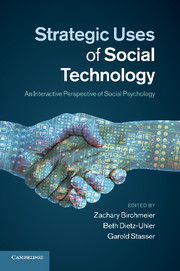Book contents
- Frontmatter
- Contents
- Figures
- Tables
- Notes on the contributors
- Acknowledgments
- 1 Introduction
- 2 A SIDE look at computer-mediated interaction
- 3 Trust, deception, and identity on the internet
- 4 An interactional approach to social influence in computer-mediated communication
- 5 Social interaction in cyberspace
- 6 Dynamics of leader emergence in online groups
- 7 Ostracism in cyberspace
- 8 Opinion-based groups
- 9 A juxtaposition of social influences
- 10 The virtual social world
- Index
- References
3 - Trust, deception, and identity on the internet
Published online by Cambridge University Press: 07 October 2011
- Frontmatter
- Contents
- Figures
- Tables
- Notes on the contributors
- Acknowledgments
- 1 Introduction
- 2 A SIDE look at computer-mediated interaction
- 3 Trust, deception, and identity on the internet
- 4 An interactional approach to social influence in computer-mediated communication
- 5 Social interaction in cyberspace
- 6 Dynamics of leader emergence in online groups
- 7 Ostracism in cyberspace
- 8 Opinion-based groups
- 9 A juxtaposition of social influences
- 10 The virtual social world
- Index
- References
Summary
The internet is a defining feature of modern life. Individuals increasingly conduct social interactions online or use other forms of mediated communication, such as text messaging. Understanding how this communication medium affects interpersonal interactions and relationships is a key task for psychologists. Specifically, researchers have been interested in the extent to which individuals are willing to trust others that they encounter online, and the degree to which this trust is justified.
Developing trusting relationships is important if connections forged online are to move to deeper levels. Trusting relationships may be more likely to provide social support and other beneficial outcomes. Of course, just as in offline relationships, appropriate calibration of trust levels is also important. If individuals are too trusting in their online interactions, others may take advantage of them. An optimal level of trust is one in which the person is open to gaining deep and fulfilling relationships, but is not gullible enough to be cheated or taken advantage of (Rotter, 1980; Yamagishi, 2001).
- Type
- Chapter
- Information
- Strategic Uses of Social TechnologyAn Interactive Perspective of Social Psychology, pp. 40 - 62Publisher: Cambridge University PressPrint publication year: 2011
References
- 2
- Cited by



